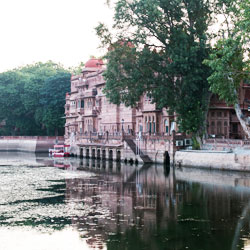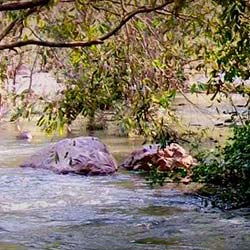
- Home
- Travel Packages
- Top Destination
-
Travel Attraction
By Category
Top Attraction

- Travel Agents
- Car Rentals
- Hotels

About Gajner Wildlife Sanctuary Gajner Wildlife Sanctuary is a popular sanctuary located in Bikaner, Rajasthan, India. It is spread over an area of 6019.60 hectares and is situated near the Gajner Palace. The sanctuary is known for its diverse flora and fauna, making it a must-visit destination for nature lovers and wildlife enthusiasts. Location and Geographical Overview The Gajner Wildlife Sanctuary is located around 32 kilometres from Bikaner city. It is situated on the banks of the Gajner Lake, which adds to the scenic beauty of the sanctuary. The sanctuary is surrounded by sand dunes, woodland areas, and a variety of vegetation that sustains the diverse wildlife population. Opening and Closing Time The Gajner Wildlife Sanctuary is open for visitors from sunrise to sunset. It is recommended to visit during the early hours of the day to witness the wildlife in their natural habitat. Entry Fee The entry fee for the Gajner Wildlife Sanctuary is INR 100 for Indian nationals and INR 300 for foreign nationals. Children below the age of 5 years can enter for free. Species-Flora/Fauna Availability The sanctuary is home to a diverse range of flora and fauna. Some of the commonly spotted animals include black bucks, desert foxes, blue bulls, chinkaras, and various bird species. The vegetation includes trees like acacia, neem, and khejri, along with shrubs and grasses. Activities Performed Visitors can indulge in various activities at the sanctuary, such as bird-watching, wildlife photography, nature walks, and jeep safaris. The sanctuary offers a unique opportunity to experience the wilderness up close. Jeep Safari Charges Jeep safaris are a popular way to explore the sanctuary and observe the wildlife in their natural habitat. The charges for a jeep safari at Gajner Wildlife Sanctuary start from INR 800 per person. Age Criterion and Entry Fee The entry fee for male and female visitors above the age of 5 years is INR 100 for Indian nationals and INR 300 for foreign nationals. Children below the age of 5 can enter for free. Senior citizens can avail of a discounted entry fee upon presenting valid identification. Senior Citizen Facilities Senior citizens visiting the sanctuary are provided with facilities like seating areas, restrooms, and water stations for their convenience. The sanctuary staff is also available to assist them during their visit. Best Time to Visit The best time to visit the Gajner Wildlife Sanctuary is during the winter months from October to March when the weather is pleasant, and wildlife sightings are more frequent. It is advisable to avoid visiting during the summer months due to the extreme heat. Nearby Places to Visit While in Bikaner, visitors can explore other nearby attractions such as Junagarh Fort, Karni Mata Temple, and Lalgarh Palace. These sites offer a glimpse into the rich history and culture of the region. Vehicle Parking Facility The sanctuary provides ample parking space for visitors who wish to bring their vehicles. The parking facility is safe and secure, allowing visitors to explore the sanctuary without any worries. Rules and Regulations Visitors are required to follow certain rules and regulations while visiting the Gajner Wildlife Sanctuary. These include maintaining cleanliness, not feeding or disturbing the wildlife, and adhering to the designated walking paths and safari routes. Smoking and littering are strictly prohibited in the sanctuary premises. How to Reach and Other Related Information The Gajner Wildlife Sanctuary is easily accessible by road from Bikaner city. Visitors can hire a taxi or use public transport to reach the sanctuary. The nearest airport is in Jodhpur, around 250 kilometres away, and the nearest railway station is in Bikaner. Accommodation options are available near the sanctuary for those looking to stay overnight. Overall, the Gajner Wildlife Sanctuary offers a unique opportunity to connect with nature and experience the beauty of Rajasthan's wildlife. With its diverse flora and fauna, scenic landscapes, and peaceful ambiance, it is a perfect destination for a memorable wildlife adventure.
Explore More
Jaisamand Wildlife Sanctuary is one of the most beautiful and diverse wildlife reserves in Rajasthan. It is located near Jaisamand Lake, the second-largest artificial lake in Asia, making it a unique destination where visitors can enjoy both nature and wildlife. The sanctuary is home to a variety of flora and fauna, offering a peaceful retreat for wildlife lovers, photographers, and adventure seekers. Location and Accessibility Jaisamand Wildlife Sanctuary is located around 50 km from Udaipur in Rajasthan, India. It is easily accessible by road and is a popular day-trip destination from Udaipur. By Road: You can hire a taxi or take a private car from Udaipur, which takes about 1.5 hours. By Train: The nearest railway station is Udaipur Railway Station, from where you can take a cab to the sanctuary. By Air: The nearest airport is Maharana Pratap Airport, Udaipur, approximately 65 km away. History of Jaisamand Wildlife Sanctuary Jaisamand Wildlife Sanctuary was established in 1957 to protect the diverse wildlife and ecological balance of the region. The sanctuary is spread over 160 square kilometers, surrounding the Jaisamand Lake, which was built by Maharana Jai Singh in 1685. The lake, along with the sanctuary, forms a unique ecosystem that supports a variety of wildlife and migratory birds. Over the years, it has become a significant conservation area and a favorite destination for nature lovers. Best Time to Visit Jaisamand Wildlife Sanctuary The best time to visit Jaisamand Wildlife Sanctuary is from October to March when the weather is pleasant, and animals are more active. Summers (April to June) can be extremely hot, making exploration difficult. Monsoons (July to September) bring lush greenery, but heavy rains may affect accessibility. Wildlife and Species Found in Jaisamand Wildlife Sanctuary Jaisamand Wildlife Sanctuary is rich in biodiversity, making it a paradise for nature enthusiasts. It houses a wide range of species, including: Mammals: Leopard – The top predator of the region. Chital (Spotted Deer) – Easily spotted in the grasslands. Sambar Deer – The largest deer species in India. Hyena – A nocturnal carnivore found in the area. Wild Boar – Roams freely in the sanctuary. Sloth Bear – Occasionally sighted. Birds: Indian Peafowl – The national bird of India, commonly found here. Kingfisher – Seen near the lake and water bodies. Eagles and Hawks – Soaring high in search of prey. Parakeets, Bulbuls, and Woodpeckers – Commonly seen in the forested areas. Migratory Birds – Arrive in winter, making it a great time for birdwatching. Reptiles: Crocodiles – Found in and around Jaisamand Lake. Snakes – Including cobras, vipers, and rat snakes. Monitor Lizards – Often seen basking in the sun. Wildlife Safari at Jaisamand Wildlife Sanctuary For those seeking adventure, a wildlife safari at Jaisamand Wildlife Sanctuary is a must! The safari takes you deep into the forest, offering a chance to spot some of the rare species in their natural habitat. Safari Timings: Morning and evening safaris are available. Safari Duration: Approximately 2 to 3 hours. Modes of Safari: Jeep Safari is the best way to explore the dense forest areas. Guided Tours: Hiring a local guide enhances the experience as they help in spotting animals and sharing interesting facts. Entry Fees and Other Costs Entry Fee: ₹50 per person (may vary for foreigners) Jeep Safari: ₹1000 – ₹3000 depending on the vehicle and group size Camera Charges: Additional charges may apply for professional cameras Things to Do in and Around Jaisamand Wildlife Sanctuary Besides enjoying the wildlife, visitors can indulge in several activities: 1. Boat Ride on Jaisamand Lake – A relaxing ride to enjoy the scenic beauty. 2. Visit the Marble Dam – An ancient structure adding charm to the landscape. 3. Bird Watching – A paradise for birdwatchers, especially during the winter. 4. Nature Walks and Trekking – Explore the forest on foot for a more immersive experience. 5. Photography – Capture the breathtaking landscapes and wildlife. Nearby Attractions 1. Jaisamand Lake – The highlight of the region, perfect for boating and picnics. 2. Devgiri Temple – A sacred site dedicated to Lord Shiva, located on a hill. 3. Dhebar Lake Marble Dam – A historical dam built alongside Jaisamand Lake. 4. Hawa Mahal of Jaisamand – A lesser-known but beautiful palace offering scenic views. Visitor Tips for Jaisamand Wildlife Sanctuary Wear Comfortable Clothing: Opt for neutral-colored clothes to blend in with nature. Carry Binoculars: Essential for birdwatching and spotting animals from a distance. Stay Hydrated: Carry water bottles, especially in warmer months. Follow Park Rules: Do not litter, feed animals, or disturb the wildlife. Best Time to Visit: Early morning or late afternoon safaris offer better chances of spotting wildlife. Conclusion Jaisamand Wildlife Sanctuary is a hidden gem near Udaipur, offering a perfect mix of adventure, wildlife, and scenic beauty. Whether you are a nature enthusiast, a wildlife photographer, or someone seeking a peaceful getaway, this sanctuary has something for everyone. So, if you’re in Udaipur, don’t miss the chance to explore this incredible sanctuary and witness the rich biodiversity of Rajasthan.
Explore More
About Trevor's Tank Trevor's Tank is a picturesque reservoir located in the beautiful hill station of Mount Abu in the Indian state of Rajasthan. This man-made tank was built by Trevor, a British engineer, to provide water to the local residents and wildlife. The tranquil surroundings and abundant flora and fauna make Trevor's Tank a popular attraction for nature lovers and bird watchers. Location and Geographical Overview Trevor's Tank is situated at a distance of about 5 kilometers from the main town of Mount Abu. It is nestled amidst lush greenery and rocky hills, offering a serene and peaceful environment for visitors to enjoy. The tank is surrounded by dense vegetation, creating a habitat for a variety of plant and animal species. Opening and Closing Time The tank is open to visitors from sunrise to sunset every day of the week. Entry Fee There is no entry fee to visit Trevor's Tank, making it an affordable and accessible destination for all. Species-Flora/Fauna Availability Trevor's Tank is home to a diverse range of plant and animal species. The surrounding vegetation includes lush green trees, shrubs, and wildflowers. Visitors can spot a variety of bird species, including peacocks, parrots, and kingfishers, as well as small mammals like squirrels and langurs. Activities Performed Visitors to Trevor's Tank can enjoy activities such as bird watching, nature walks, and photography. The peaceful surroundings make it an ideal spot for relaxation and rejuvenation amidst nature. Jeep Safari Charges There are no jeep safari facilities available at Trevor's Tank. Age Criterion and Entry Fee There are no specific age criteria for visiting Trevor's Tank. Visitors of all ages are welcome to explore the natural beauty of the tank. Since there is no entry fee, there are no charges for adults, children, or senior citizens. Senior Citizen Facilities Senior citizens can enjoy the peaceful atmosphere of Trevor's Tank and take leisurely walks around the reservoir. The serene surroundings provide a relaxing environment for older visitors to unwind and connect with nature. Best Time to Visit The best time to visit Trevor's Tank is during the monsoon season, from July to September, when the surrounding vegetation is lush and green. The rainy season also attracts a variety of bird species, making it an ideal time for bird watching. Nearby Places to Visit Some of the nearby attractions to Trevor's Tank include Mount Abu Wildlife Sanctuary, Dilwara Temples, Nakki Lake, and Guru Shikhar. Visitors can explore these destinations to get a complete experience of the natural and cultural heritage of Mount Abu. Vehicle Parking Facility There is a designated parking area near Trevor's Tank where visitors can park their vehicles. The parking facility is provided free of charge for the convenience of visitors. Rules and Regulations Visitors are required to maintain the cleanliness and serenity of Trevor's Tank by not littering or disturbing the natural habitat. It is advised to respect the flora and fauna in the area and follow all the rules and regulations set by the authorities. How to Reach and Other Related Information Trevor's Tank is easily accessible by road from the main town of Mount Abu. Visitors can hire a taxi or auto-rickshaw to reach the tank, which is located about 5 kilometers away. The nearest airport is Udaipur Airport, which is about 176 kilometers from Mount Abu. The nearest railway station is Abu Road, which is about 27 kilometers from the town. Overall, Trevor's Tank is a must-visit destination for nature enthusiasts and those looking to explore the natural beauty of Mount Abu. With its serene surroundings, diverse wildlife, and peaceful atmosphere, the tank offers a unique and rejuvenating experience for visitors of all ages.
Explore More
About Bassi Wildlife Sanctuary Bassi Wildlife Sanctuary is a serene and picturesque sanctuary located in the Chittorgarh district of Rajasthan, India. It covers an area of approximately 153 square kilometers and is home to a variety of flora and fauna, making it a popular destination for nature lovers and wildlife enthusiasts. Location and Geographical Overview The sanctuary is situated in the foothills of the Aravalli Range, approximately 5 kilometers from the town of Bassi. It is easily accessible by road and is located about 25 kilometers from the city of Chittorgarh. Open and Closing Time The sanctuary is open to visitors from 6:00 AM to 6:00 PM every day of the week. Entry Fee The entry fee for Indian nationals is INR 100 per person, while the fee for foreign nationals is INR 400 per person. Species-Flora/Fauna Availability Bassi Wildlife Sanctuary is home to a diverse range of flora and fauna, including species such as panthers, sloth bears, hyenas, antelopes, and various bird species. The sanctuary is also known for its rich vegetation, with a variety of trees, shrubs, and grasses found throughout the area. Activities Performed Visitors to the sanctuary can enjoy activities such as nature walks, bird watching, and jeep safaris to explore the wildlife and natural beauty of the area. The sanctuary also offers opportunities for camping and picnicking amidst the tranquil surroundings. Jeep Safari Charges The charges for a jeep safari in Bassi Wildlife Sanctuary typically range from INR 500 to INR 1000 per person, depending on the duration of the safari and the number of participants. Age Criterion and Entry Fee There is no specific age criterion for entry into the sanctuary. The entry fee for children under the age of 5 is free, while the fee for children aged 5-12 is INR 50 per child. For male and female adults, the entry fee is INR 100 per person. Senior Citizen Facilities Senior citizens can avail of discounted entry fees at Bassi Wildlife Sanctuary. The sanctuary also offers facilities such as seating areas and restrooms to ensure the comfort and convenience of elderly visitors. Best Time to Visit The best time to visit Bassi Wildlife Sanctuary is during the winter months, from October to March, when the weather is pleasant and the wildlife is more active. This time of the year also offers the opportunity to witness migratory birds in the sanctuary. Nearby Places to Visit Some of the nearby attractions to visit while in the vicinity of Bassi Wildlife Sanctuary include Bassi Fort, Chittorgarh Fort, and the village of Menal with its ancient temples and picturesque surroundings. Vehicle Parking Facility The sanctuary provides a designated parking area for vehicles near the entrance, where visitors can safely park their cars or buses before exploring the sanctuary on foot or by jeep safari. Rules and Regulations Visitors to Bassi Wildlife Sanctuary are required to follow certain rules and regulations to ensure the safety of the wildlife and the preservation of the natural environment. Some of the common rules include refraining from littering, feeding the animals, and making loud noises that could disturb the wildlife. How to Reach and Other Related Information Bassi Wildlife Sanctuary is easily accessible by road from Chittorgarh, which is well-connected to major cities in Rajasthan. The nearest railway station is located in Chittorgarh, approximately 25 kilometers away from the sanctuary. Visitors can also hire taxis or take a bus from Chittorgarh to reach the sanctuary. Overall, Bassi Wildlife Sanctuary offers a peaceful retreat amidst nature, where visitors can immerse themselves in the beauty of the wilderness and witness the fascinating wildlife that inhabits the area. Whether you are a wildlife enthusiast, nature lover, or simply seeking a tranquil escape from the hustle and bustle of city life, a visit to this sanctuary is sure to leave you rejuvenated and inspired.
Explore MoreRajasthan Jaipur(2N), Bikaner(1N), Jaisalmer(2N), Jodhpur(1N), Udaipur(2N) Package
9 Days/ 8 Night
Jaipur - Bikaner - Jaisalmer - Jodhpur - Udaipur
Royal Rajasthan Tour - 7 Days
7 Days/ 6 Night
Bikaner - Jaipur - Jaisalmer - Jodhpur
3D - 2N Jaipur Tour Package
3 Days/ 2 Night
Jaipur
The Golden Triangle - 5 Nights 6 Days
6 Days/ 5 Night
Agra - Jaipur - New Delhi